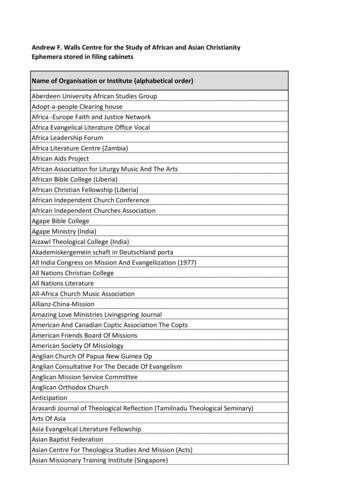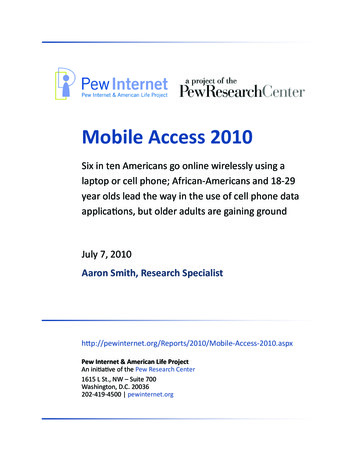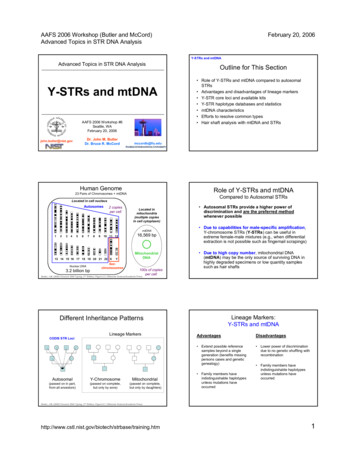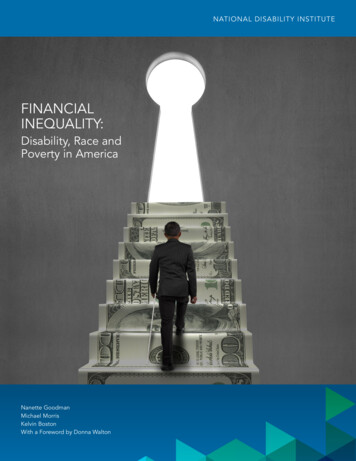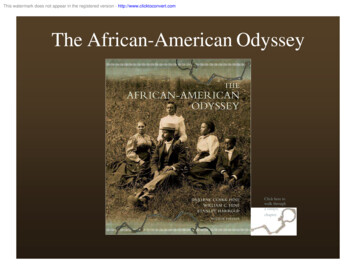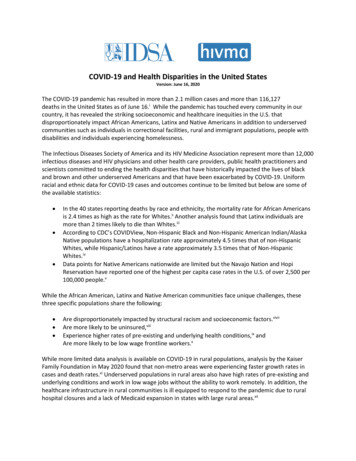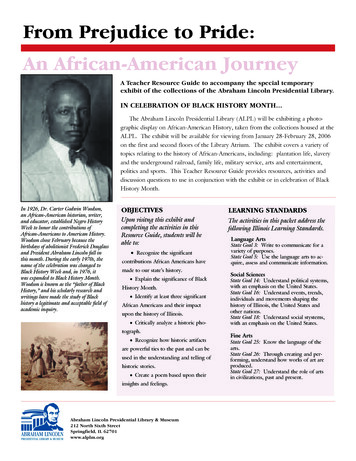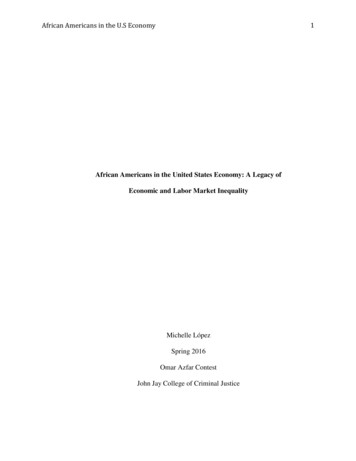
Transcription
1African Americans in the U.S EconomyAfrican Americans in the United States Economy: A Legacy ofEconomic and Labor Market InequalityMichelle LópezSpring 2016Omar Azfar ContestJohn Jay College of Criminal Justice
African Americans in the U.S Economy2I. AbstractFor years, African Americans have been subject to labor market unfairness and economicinequality, discrimination, and oppression. Although the concept of economic inequality andlabor market discrimination within the African American community is not a new concept in theUnited States, it continues to garner attention as African Americans continue to be one of the topminority groups who live in poverty (BLS, 2016). In order to understand the inequalities AfricanAmericans face in the United States economy, it is vital that one first takes into account one ofthe many concepts the black political economy paradigm and liberals emphasize: history. Thedivision between Whites and Blacks set forth during the slave era in the seventeen andeighteenth centuries was the first stage in which African American inequality was established;though they helped build the world economy through the fruit of their labor, African Americanswere set to economically fail.During the slave period, the Europeans carried much of the economic power whereasAfrican Americans were the “properties” [slaves] of the Whites. With slavery came the buildingof the concepts white supremacy and race, which have played an immense factor in maintainingeconomic inequality and labor market unfairness. Though the quest for equality still has a longway to go, scholars such as James B. Stewart, Major Coleman, William Darity Jr, JohnWhitehead, Peter Bohmer, and Jessica Gordon Nembhard have all helped pave the way forAfrican American economic and labor market justice in the United States. In the quest toexamine African American economic inequality and labor market unfairness, this paper willanalyze the historical economic context of slavery in the United States, neoclassical and liberalideologies, the black political economy paradigm, the reality of African American economicinequality in the 21st century and social movements.
African Americans in the U.S Economy3II. Slavery & the Rise of a World EconomyDuring the seventeen century many countries, mainly European, began to partake in thedeplorable practice of slavery. Slavery as defined by the Abolition Project (n.d), was the practicein which individuals were owned, classified as a form of property and thus forced to do as wastold for no pay. The practice of slavery, as put forth by Darity (n.d.), made hundreds of Africansavailable at high prices which ultimately raised profits in American agriculture; these profitshowever, were unbalanced. Darity (n.d.) also notes that the enslavement of African Americanswas driven by one main reason: greed for profits, which later allowed for the production of antiBlack sentiment. The ongoing slave trade during this era allowed various participating countriesto experience rapid economic development.The consequence in Africa was failure. The Atlantic Slave Trade helped set forth theimbalance of economic power between Africans and Whites. In “Africa, Europe, and the Originsof Uneven Development: The Role of Slavery” William A. Darity Jr (n.d.) notes the following:The labor force for development of a manufacturing sector was not present Furthermoredepopulation undermined the presence of sufficient density of population to produce themarket demand that would have provided the necessary stimulus for the growth ofindustry (p. 18).As the trade entered the United States, it comes as no surprise that the disbursement of unevenbenefits was also brought in for African Americans. In “The Critical Role of African Americansin the Development of the Pre-Civil War U.S. Economy”, James B. Stewart (n.d.) notes that“enslaved Africans was especially vital to the development and performance of the U.S.economy in the latter decades of the eighteenth century and the first decade of the nineteenthcentury.”
African Americans in the U.S Economy4The slave-based system helped produce immense profits through the abuse of black laborand set forth an economy that was becoming dependent of slave labor far into the civil war(Stewart, n.d.). As profits were generating, the widening of economic gains between Whites andBlacks were evident. Stewart (n.d.) states that Blacks were unable to participate in post civil-wareconomic development. In regards to property ownership, Stewart concludes by providing analarming statistic that still lingers today: “the average per-capita property assessments for Blackswere 9.73 in 1880, compared to 296.18 for whites; this disparity in wealth holdings betweenboth races “constitutes one of the most enduring legacies of the exploitation experienced byBlacks during slavery” (p.29). With slavery came the building of racism and discriminationtowards the Black race.III. Establishment of Race, Racism & White SupremacyAccording to Keith Lawrence and Terry Keleher (2004) in Chronic Disparity: Strong andPervasive Evidence of Racial Inequalities POVERTY OUTCOMES, race was used as aclassification to assign ones social worth and status, which would ultimately establish andmaintain the individual’s privilege and power. With the concept of race, came the concepts ofwhite supremacy and prejudice. White supremacy, as put forth by Lawrence and Keleher (2004),has been a historically perpetuated system, where whites are economically held at a higherpedestal while accommodating institutions to exploit and oppress people of color. The concept ofwhite supremacy eventually led to the notions of discrimination, prejudice, and racism that createlabor market unfairness. Today, many forms of racism exist, but the two most prevailing formsthat have maintained African Americans at a lower economic platform than Whites are structuraland institutional racism.
African Americans in the U.S Economy5Lawrence and Keleher (2004) note that structural racism “routinely advantages whiteswhile producing cumulative and chronic adverse outcomes for people of color” (p. 1) andinstitutional racism is the “discriminatory treatment, unfair policies, and inequitableopportunities and impacts, based on race, produced and perpetuated by institutions” (p. 1);institutional racism is embedded within our educational system, government, and business sector.James B. Stewart (2008) notes in Africana Studies and Economics In Search of a NewProgressive Partnership that the racism formed early on was the result of “the successful effortsof capitalists to divide the proletariat and expressed caution about analyses emphasizing race as aprimary factor in explaining economic oppression” (p. 799); these forms of racism can arguablybe one of the many barriers that continue to stunt black economic progress. In Thomas andPowell’s “Toward a Path to Structural Racism” (2006) the authors note that social structureshave promoted unequal economic good and services distributions. The establishment ofinstitutions have helped limit the access to opportunity restricting African American economicsuccess in the United States (Thomas & Powell, 2006IV. Neoclassical v. Liberal IdeologiesWhen discussing economic and labor market inequality, it is important to discuss theviews of the neoclassicals and liberals. In Cecilia A. Conrad’s (2005) work titled AfricanAmericans in the U.S. Economy, the author emphasizes from the very beginning that neoclassicaleconomics has failed to explain the current differences in economic status between AfricanAmericans and Whites. Neoclassicals, also known as the “conservatives”, revolve around twomain arguments to explain the economic differences between the two races; these two argumentsinclude the following: 1) competitive markets will eliminate discrimination and 2) Black-Whiteincome disparities are a result of racial differences in culture, taste, etc. However, liberal
African Americans in the U.S Economy6economists have repeatedly argued that competitive markets will do the exact oppositeneoclassicals note; as put forth by Conrad, (2005): “competitive markets tend to reproduce theinequality that racial bias created” (p. 2).Liberals on the other hand, recognize that income disparities between Blacks and Whitesare not a result of making poor decisions as argued by William Darity (2003). Scholar JohnWhitehead (n.d.) notes that liberals have argued for years that it is vital that the concept oflassiez-faire is destroyed. According to liberals, government intervention is needed. Whiteheadnotes that the government needs to make education and training readily available for the Blackcommunity in order to improve their skills and have a successful and well paying profession(Conrad, 2005). According to the Bureau of Labor Statistics (2015), as of 2015, thirty-sevenpoint seven percent of Whites had a college bachelor’s degree compared to the twenty-sevenpoint three of African Americans; BLS concluded (2015), “individuals with higher levels ofeducation are more likely to be employed in higher-paying jobs—such as those in management,professional, and related occupations—than are individuals with less education” (p. 1). Bymaking education and training available to the African American community, thousands of lowincome “minorities” have a better chance at entering the labor market and economically progresswith high paying jobs.Another factor that liberals argue creates economic inequalities for African Americans isglobalization. Jessica Gordon Nembhard, et al., (n.d.) argue that though globalization can lead toeconomic prosperity, minorities are often faced with its downfalls. With a rise in technology, theservice sector over manufacturing has created labor market inequality (Conrad, 2005). Theauthors also note that during globalization, capitalist corporations’ main objective is to gainprofits; with the sole intention to gain profits, the capitalists tend to disregard the potential effects
African Americans in the U.S Economy7of their behavior and who gets hurt. For this reason, throughout the 1900’s various organizationsbegan to fight for economic equality, which will be discussed later on in this paper.V. Black Political Economy ParadigmOne very important paradigm that has fought to give African Americans better economicopportunities is the black political economy paradigm. As James B. Stewart and Major Coleman(n.d.) note, the black political economy paradigm notes that racial identity is a form of property,which has income and wealth generating characteristics. Stewart and Coleman then note that thetwo major focuses of this paradigm are that economic forces tend to intensify conflicts that resultfrom different racial groups and that economic institutions are organized to accommodatepatterns of racial stratification. Within this paradigm, race plays a very important role becauseaccording to the authors, the usage of race by individuals shows that “collective identity is apotentially important dimension of economic behavior” (p. 119). The BPE paradigm alsoanalyzes racial stratification and economics. In Stewart’s (2006) Thomas Sowell’s QuixoticQuest to Denigrate African American Culture, the author notes the following:Stratification economics is an emerging subfield that examines the structural andintentional processes generating social hierarchy and income and wealth inequalitybetween inscriptively distinguished groups (p. 463).In the black political economy paradigm, the term racial stratification helps explain whyAfrican Americans are held at a lower pedestal than whites. According to Stewart and Coleman(n.d.), race is used in various institutions and organizations in order to assign roles and positionsto workers. The process by which race is used to assign roles has heavy wage implications forthousands of African Americans. According to Jessica Gordon Nembhard, Patrick Mason,Steven C Pitts (n.d.), the low positioning of African Americans in organizations and institutions
African Americans in the U.S Economy8have created immense differences in wages; as put forth by the authors: “African Americans holdonly fifteen cents of wealth to every dollar of wealth held by white households” (p. 215). Inaiding to help African Americans achieve economic equality, the black political economyparadigm has various suggestions similar to that of liberals. One of the many suggestions offeredby the black political economy paradigm is that individuals should mutually commit resources,whether they are economic or noneconomic, to political activities; by doing so, the voices ofthousands of African Americans fighting for economic equality will be heard.VI. Economic Inequality TodayToday in the twenty first century, the racial wealth gap between African Americans andWhites is widening at an impressive and alarming rate. According to the Center for GlobalPolicy Solutions (2014), the median wealth of White households is twenty times greater whencompared to that of African American households. In 2005, African American wealth wasestimated at twelve thousand dollars and in 2009 it declined drastically to five thousand. Asmany liberals have noted, the barriers to economic and social equality that have kept AfricanAmericans behind the economic curtain is largely due to the fact that institutions andorganizations continue to keep it this way. Today, African American families lack “the necessarysavings and investments to climb up the economic ladder” (p. 1).The Center for Global Policy Solutions (2014), sources the widening wealth gap toincome inequality as a result of labor market discrimination. In terms of income, AfricanAmerican families earned approximately thirty-three thousand dollars compared to fifty-seventhousand dollars obtained by White families. Since organizations and institutions often play intostereotypes (e.g. the rejection of African American on the sole basis of his or her name, the“violent” and “aggressive” characteristic), Blacks settle for low paying jobs that, in the most
African Americans in the U.S Economy9part, give them no opportunity to “climb the work latter” (Center for Global Policy Solutions,2014). The Center for Global Policy Solutions (2014), also notes that as of 2014, twelve percentof African Americans remain unemployed when compared to the low five percent forWhites. Current statistics provided by the Bureau of Labor Statistics continues to show slow, ifany, black advancement. As of March 2016, more than one hundred thousands Whites areemployed compared to an astonishing seventeen thousand African Americans (BLS, 2016).VII. Fight for Economic JusticeThough African Americans have faced immense oppression in the United States,prominent leaders such as Martin Luther King Jr. and Malcolm X have all fought for blackeconomic and social progress. Mr. King devoted himself to the fight for African American rightsin the United States. Prior to his death on April 4th, 1968, Mr. King had been planning the PoorPeople’s Campaign march which aimed to “dramatize the reality of joblessness and deprivationby bringing those excluded from the economic to the doorstep of the nations’ leaders (Weissman,2013:1); by dramatizing the reality, King aimed to help African Americans receive a decentliving through a middle-class income. Following Martin Luther King Jr’s aspirations for theAfrican American community, Malcolm X (1964) also sought to bring light to economicinequality in the Black community and noted the following:The political – The economic philosophy of Black Nationalism only means that we haveto become involved in a program of reeducation to educate our people into theimportance of knowing that when you spend your dollar out of the community inwhich you live, the community in which you spend your money becomes richer andricher; the community out which you take your money becomes poorer and poorer. Andbecause these negroes, who have been mislead, misguided, are breaking their necks to
African Americans in the U.S Economy10take their money and spend it with The Man, The Man is becoming richer and richer,and you’re becoming poorer and poorer. And then what happens? The community inwhich you live becomes a slum. It becomes a ghetto. The conditions become run down(p. 1).The creation of organizations and movements such as the Black Panthers also helpedvoice the economic rights of thousands of African Americans in the United States; as put forthby the Hoover Archives (n.d.), this party was the epitome of the Black Power Movement.Founder Huey P. Newton and Bobby Seale, the Black Panther Party sought to achieve blackeconomic, political, and social equality through mass organization and community basedprograms (Baggins, 2002). With the uprising of African American movements, hundreds ofAfrican Americans were unfortunately harassed by government officials and police. In their tenpoint program, the Black Panthers noted the position that the economy played on AfricanAmericans and vice versa. In point two, the Black Panthers emphasized the want for fullemployment for the African American community; the panthers argued that the federalgovernment was responsible and obligated to secure full employment for man.Secondly, the Panthers stated that capitalists have continuously undermined theirpotential growth; as put forth by Baggins (2001): “we believe that this racist government hasrobbed us, and now we are demanding the overdue debt of forty acres and two mules. Forty acresand two mules were promised 100 years ago as restitution for slave labor and mass murder ofBlack people. We will accept the payment in currency, which will be distributed, to our manycommunities” (p.1). Although movements like these have pushed for African Americaneconomic equality, there still is a long way to go as institutional and structural racism as well asmany other factors has deprived African Americans of economic opportunity.
African Americans in the U.S EconomyIt is vital that we continue to take measures to have the voices of African Americansheard and that we continue to address economic and labor market inequality created byembedded racism and discrimination in organizations and institutions. Unless we tackle theclass-differentiated system in the United States, African American economic inequalities willcontinue to persist (Darity, 2003). As put forth by The Center for Global Policy Solutions(2014): “the sooner we address these issues, the sooner we will become a more economicallyprosperous nation where all families can reap the rewards for their hard work” (p. 6).11
12African Americans in the U.S EconomySourcesBaggins, B. (2001). Retrieved from -panthers/1966/10/15.htmBaggins, B. (2002) History of the Black Panther Party. Retrieved thers/Conrad, C. (2005). African Americans in the U.S. Economy. Lanham, Maryland:Rowman & Littlefield Publishers.Darity Jr, A., W. (n.d.). Africa, Europe, and the Origins of Uneven Development: The Role ofSlavery. In C. Conrad (Ed.), African Americans in the U.S. Economy. (pp. 14-19).Lanham, Maryland: Rowman & Littlehead PublishersJr, William., W. (2003). Will the Poor Always Be With Us? Review of Social Economy, 61(4),471-477. Retrieved from Taylor & Francis, LtdLawrence, K. & Keleher, T. (2004). Chronic Disparity: Strong and Pervasive Evidence of RacialInequalities POVERTY OUTCOMES. Retrieved from 20of%20Racism.pdfMalcolm X. (1964). The Ballot or the Bullet. Retrieved from www.digitalhistory.uh.edu/dispTextbook.cfm?smtid 3&psid 3624Nembhard, G., J. & Pitts, C., S., & Mason, L., P. (n.d.). African American IntragroupInequality and Corporate Globalization. In C. Conrad (Ed.), African Americans in theU.S. Economy. (pp. 208-222). Lanham, Maryland: Rowman & Littlehead PublishersStewart, B., J. (2006). Thomas Sowell’s Quixotic Quest to Denigrate African American Culture:A Critique. The Journal of African American History, 91(4), 459-465. Retrieved fromJSTOR database.
African Americans in the U.S Economy13Stewart, B., J. Africana Studies and Economics In Search of a New Progressive Partnership.Journal of Black Studies, 38(5), 795-805. Retrieved from SAGE Publications, Inc.Stewart, B., J. & Coleman, M. (n.d.). The Black Political Economy Paradigm and theDynamics of Racial Economic Inequality. In C. Conrad (Ed.), African Americans in theU.S. Economy. (pp. 118-132). Lanham, Maryland: Rowman & Littlehead PublishersStewart, B., J. (n.d.). The Critical Role of African Americans in the Development of the PreCivil War U.S. Economy. In C. Conrad (Ed.), African Americans in the U.S. Economy.(pp. 20-31). Lanham, Maryland: Rowman & Littlehead PublishersThe Abolition Project. (n.d.). What is Slavery? Retrieved from abolition.e2bn.org/slavery 40.htmlThomas, G., A. & Powell, A., J. (2006). Toward a Structural Racism Framework. Retrievedhttp://www.prrac.org/full text.php?text id 1095&item id 10188&newsletter id 90&header raceUnited States Bureau of Labor Statistics. (2016). Educational Attainment and OccupationGroups by Race and Ethnicity in 2014. Washington, DC.: Government Printing Office.Weissman, J. (2013). Martin Luther King's Economic Dream: A Guaranteed Income for AllAmericans. Retrieved from or-all-americans/279147/Whitehead, J (n.d.). Racial Economic Inequality and Discrimination: Conservative andLiberal Paradigms Revisited. In C. Conrad (Ed.), African Americans in the U.S.Economy. (pp. 83-93). Lanham, Maryland: Rowman & Littlehead Publishers
examine African American economic inequality and labor market unfairness, this paper will analyze the historical economic context of slavery in the United States, neoclassical and liberal ideologies, the black political economy paradigm, the reality of African American economic inequality in the 21st century and social movements.


